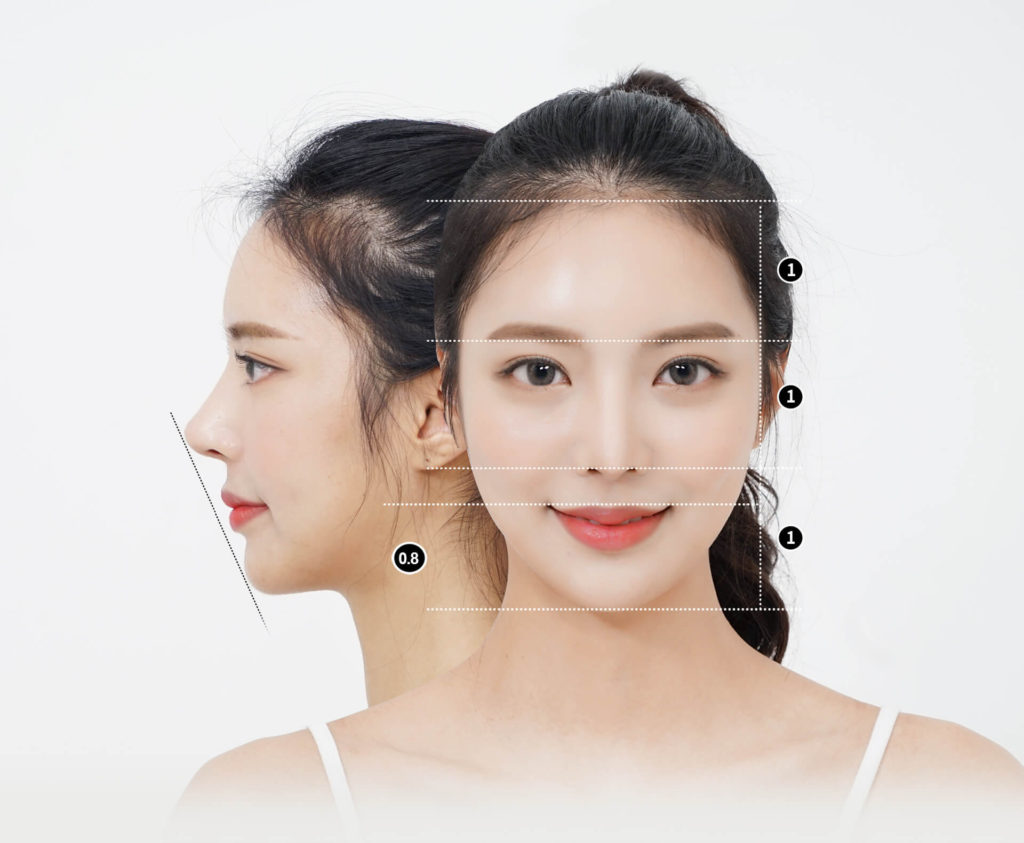When it comes to facial proportions, there are a few protruding features that determines your overall appearance. These features include your forehead, nose, and chin. And when your forehead-nose-chin ratio is balanced, you look more attractive at your front as well as side profile.
In a nutshell, your overall facial balance changes based on the shape, length of your chin and how it is located. So if your chin is too short or too long, your facial proportions look imbalanced. In such cases, genioplasty might be for you.
So, what’s the ideal face to chin ratio, you might ask. Well, read along for more information!
Golden ratio of the perfect chin
Actually, your chin defines your overall facial balance, especially your facial silhouette from your side profile. Here’s the optimal ratio for the perfect chin for your face:

- Golden ratio for forehead to eyebrow to tip of nose to chin is 1:1:1.
- Optimal ratio of nose tip to chin is 1:0.8.
- Straight line from the tip of your nose to your lips to your chin, when viewed from your side profile.
What is genioplasty surgery?
Genioplasty or chin augmentation is a plastic surgery procedure that enhances the appearance and shape of the chin by fixing specifically the frontal part of your jawbones. It is suitable for those who want to correct:
- Receding or weak chins
- Small chins that creates the appearance of a double chin
- Short chins
- Protruded chins
- Overly long chins
However, if your chin is too small or too short, there are insufficient bones available to lengthen or correct your chin deficiencies. In such cases, chin implants are necessary.
Benefits & risks of genioplasty surgery
Some benefits of chin surgery include:
- Helps with a v-line face shape
- Balances your facial features
- Defines your face-to-neck boundary
- Giving your jaw a more beautiful contour
- Facial harmony from your side profile
- Effective in creating a beautiful neckline without the use of implants
And as with all other surgical procedures, it does come with some side effects and risks of its own. Side effects and risks include:
- Droopy or saggy skin at jawline – occurs if excessive bones are being removed but can be fixed with treatments such as thread lift, SMAS facelift or full face lift
- Irreversible results when too much bones are cut off
- Risk of nerve damage if your surgeon is not skilled enough
Genioplasty surgical methods
There are generally 4 different techniques for genioplasty, and the method used largely depends on your current bone structure. You don’t have to worry about visible scarring because incisions are inside your mouth (bottom gum area).
1. T-osteotomy (for wide and long chins)

- T-shaped cut is performed (under the chin nerves) and excess bones removed.
- Remaining bones brought together then fixed with pins.
- Excess jawbones shaved off for smoother contours of jawline.
T-osteotomy method is used when your nerves are located on the upper part of your chin. Most effective method for wide and long chins.
2. Inverted V-shaped osteotomy (for wide and big chins)

- An inverted v-shaped cut (shaped like an arrow pointing up) is performed and removed.
- Remaining ends brought together then fixed with pins.
- Excess jawbones shaved for smoother contours of jawline.
Inverted v-shape osteotomy is best for when nerves are located on the lower part of your chin. Most effective method for wide and big chins.
3. Modified V-shaped osteotomy (for not too wide or long chins)

- Excess bones (in the shape of an inverted v) are removed.
- Remaining bones shifts up then fixed with pins.
- Excess jawbones shaved for smoother contours of jawline.
Modified V-shaped osteotomy is used when your nerves are located on the lower part of your chin. Most effective method for chins that are not too wide and not too long.
4. Sliding genioplasty (for receding or overly protruding chins)

- Horizontal cut of the front chin bones.
- Bones slide either forward (for receding chins) or backward (for protruding chins).
- New positions fixed with pins.
- Excess jawbones shaved off for smoother contours, if necessary.
The sliding method is best used when you don’t need to remove excess bones. Because your chin will be cut accordingly to avoid your nerves. Most effective method for receding or protruded chins.
How long does genioplasty surgery take?
Genioplasty surgery in Korea typically takes 40~60 mins and is performed under general anesthesia.
When can I see results?
Major bruising and swelling (about 70%) will last 2~3 weeks. Actual results can be seen after 3 months. There will be surgical tape taped around your chin after surgery to help compress swelling. Keep it on for at least 2~3 days, or as advised by your surgeon.
During the healing period, dental care is extremely important in order to avoid infections. Do not use your jaw muscles excessively or open your mouth too big for at least 1-2 months.
Actual recovery time vary among individuals, and is subjected to one’s health condition & healing response.
How long should I stay in Korea?
Hospitalization is not required as genioplasty surgery in Korea is a minor surgery. But do stay in Korea until your stitches are removed. And go shopping in the meantime!
Stitch removal
Stitch removal is done 10~14 days after surgery.
Cautions on stitch removal
If you remove the stitches earlier then advised, your wound might reopen, causing an infection. But if you remove it too late, you risk further scarring and pigmentation.
Don’t rush the recovery procedure for best results!
Due to time constraints, you might consider to remove your stitches at the local hospitals in your home country. Although it is possible (but not recommended), it is subjected to your doctor’s approval, and your healing progress.
Alternatives to genioplasty surgery
Other alternatives to genioplasty surgery includes chin fillers or fat injections. Fillers or fat injections can help lengthen and contour receding or short chins. However, results are only temporary and are not effective for wide or long chins. So if you have a wide or long chin, genioplasty is the best solution to your problem.
What other surgery complements genioplasty surgery?
1. Square jaw reduction surgery
Combine square jaw reduction surgery with genioplasty for more dramatic results on your lower jaw.
2. V-line surgery
V-line surgery is the combination of square jaw reduction surgery and genioplasty to give you a slender and smooth jawline, all the way from your ears to your chin.
3. Cheekbone reduction surgery (Zygoma reduction)
Getting cheekbone reduction surgery if you have overly protruded cheekbones will help to improve your overall facial contours.
4. Facelifts
If you are experiencing saggy jowls after your jaw surgery, fret not! Because it can be fixed with treatments such as thread lift, SMAS facelift or full facelift.
5. Neck lift
A young face with a saggy neck don’t go well! If you want to get rid of loose neck skin or double chin, a neck lift surgery is probably your best bet.
Conclusion
Apart from your jawlines, your chin actually plays an important part in giving you that v-shaped face which makes you look younger and more feminine. To many, genioplasty might seem like it is a small change in one’s facial features. But in actual fact, it plays a significant part in altering your facial proportions and enhancing your side profile.
Therefore, it is very important for you to get a highly skilled doctor who is experienced in chin contouring surgeries. Not to mention, adequate rest during the recovery period as well as strict implementation of your surgeon’s post-op instructions.
anti-aging cosmetic surgeryanti-aging plastic surgeryanti-aging procedurechin augmentationchin surgery in koreacosmetic surgery in koreajaw surgery in koreaKorean face contouring surgerykorean jaw surgerykorean v-line surgeryplastic surgery in koreav-line surgery in korea









What do you think?